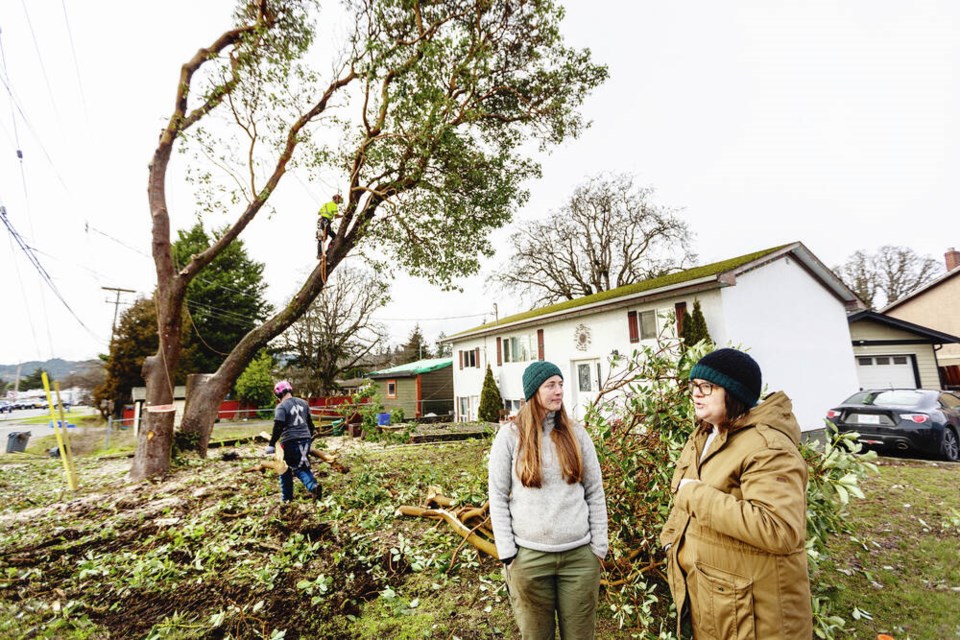A large arbutus tree at the corner Dunford Avenue and Jacklin Road in Langford fell piece by piece on Wednesday morning.
The tree’s large canopy disappeared and chunks of its three trunks were cut up within a few hours.
“I’m devastated, just in shock watching this,” said Kristen Awram, a Langford resident who gathered just over 1,700 signatures in an effort to save the 40-foot-tall tree.
The arbutus’s age was never determined, but Awram said it was a landmark and the “heart and lungs of Langford” for decades.
Coun. Keith Yacucha called it a sad day for Langford. “This tree was an icon of this corner, but not identified for retention during the rezoning last year,” he said on Twitter. “While not all trees can be saved, we must do better at preserving what we can when we can.”
Despite the timing of the removal — just days after the city passed a tree-protection bylaw — the cutting was legal and approved.
The site is being prepared for Jagpal Development’s Langford Centre downtown project, which will see two condominium towers and as many as 350 units rise from five single-family lots. The property at 906 Dunford Rd. was rezoned last year by the previous mayor and council.
The recently adopted tree-protection bylaw does not include properties within Langford’s development permit area, which covers about 70% of the city, including most of downtown, Bear Mountain, Skirt Mountain and Westhills.
An advertisement in the Goldstream Gazette this week, headlined “Press Release January 2023” but with no indication of who purchased it, says developing the land required the removal of several mature trees, most notably the arbutus on the Jacklin Road frontage.
“While this tree has done well to survive in the urban environment, the project arborist has determined that it would be unlikely to survive adjacent to this scale of development due to the inherent sensitivity of the species,” it says.
The ad notes that arbutus trees are only provincially protected when associated with a Douglas fir-arbutus ecosystem and the tree at Jacklin and Dunford is a standalone specimen.
Calls to the developer were not immediately returned.
The advertisement says the developer is committed to planting 26 trees on the property “that would be more suitable to the urban environment and eventually grow to achieve the same canopy, habitat and environmental benefits.” It also says the developer wants to work with the city to plant three arbutus trees in a “more suitable environment.”
The ad cites the benefits of housing hundreds of people on a site that previously had five small homes, saying housing is urgently needed. “The acres of raw forest that would have to be razed to provide housing if urban centres did not densify would be devastating.”
Still, Awram believes the arbutus could have been saved, saying trees with such large canopies should be treated as “critical infrastructure.”
She commissioned arborist Ryan Senechal for an assessment of the arbutus where he measured rainwater interception, pollution removal and carbon sequestering, among other benefits.
His report noted that replacing the arbutus’s 201-square-metre canopy would require either 80 replacement trees at the time of planting or 13 replacement trees and 15 years of growth.
The report added that leaving the mature arbutus would provide sound and visual buffering from a busy intersection, absorb stormwater, and reduce temperatures via shade.
It would also capture pollutants at a busy intersection, the report says, noting the species is of high value for wildlife, particularly for foraging birds and pollinating insects.
Arbutus trees, Canada’s only native broadleaf evergreen, are protected in Victoria and Saanich when they reach certain diameters, and can’t be removed without special permits — typically only issued for trees that pose a danger.
>>> To comment on this article, write a letter to the editor: [email protected]




